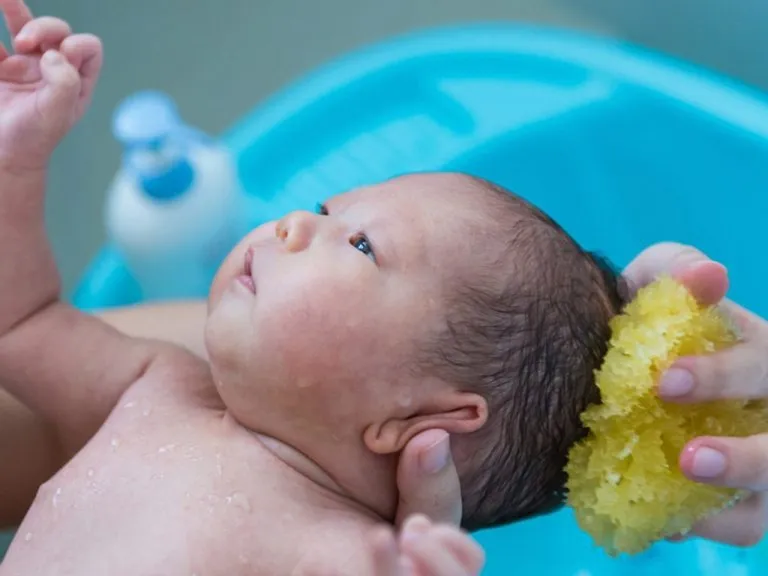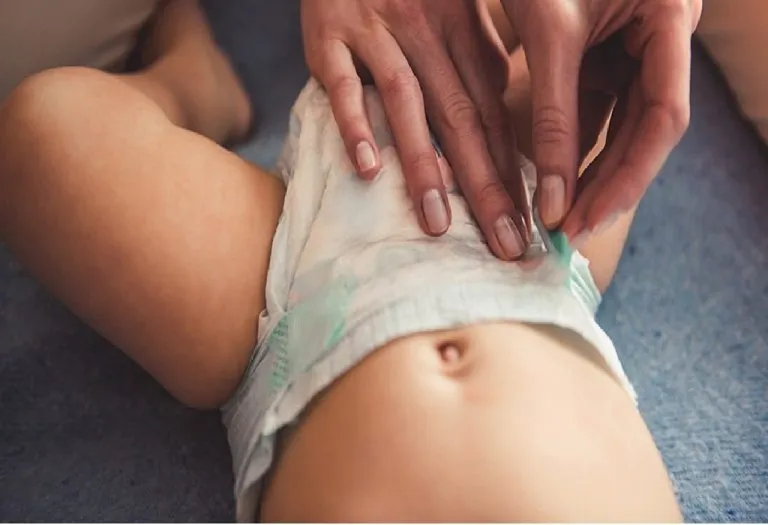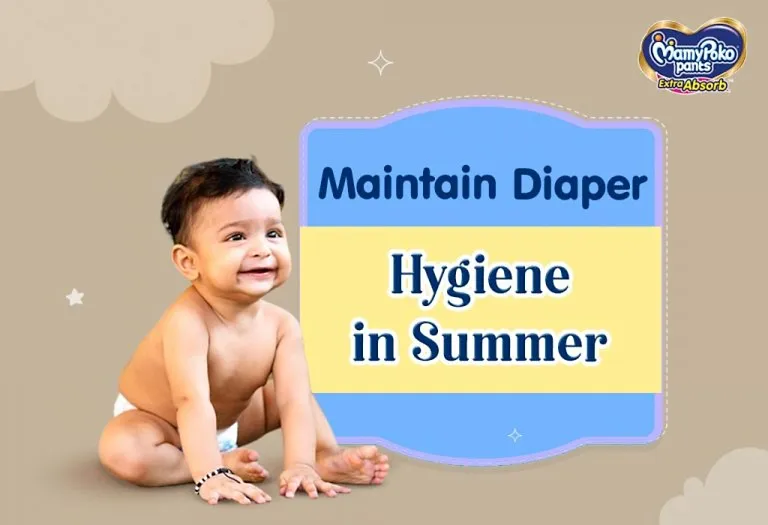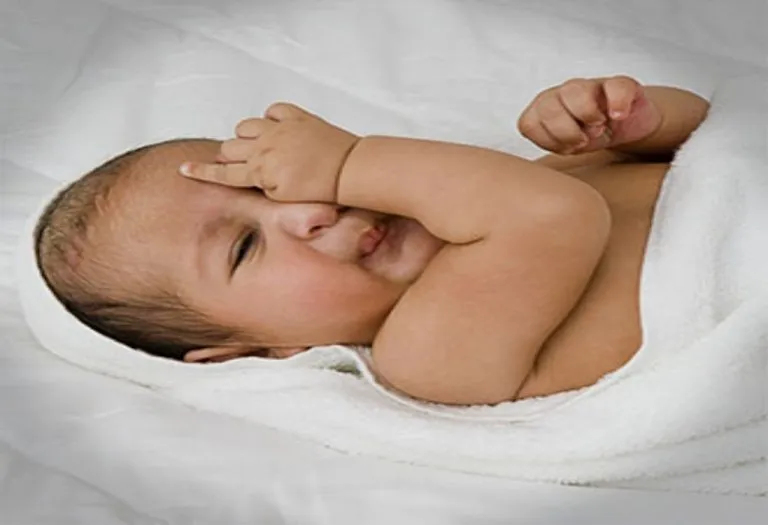How to Give Sponge Bath – Parents’ Guide

- What Is a Sponge Bath?
- Benefits of a Sponge Bath
- How Does a Sponge Bath Differ From Other Types of Baths?
- When You Should Give Your Baby Their First Sponge Bath
- Preparation for an Infant’s Sponge Bath
- How to Give a Newborn a Sponge Bath
- Are There Any Risks of Sponge Bathing?
- How Frequently Should You Give Your Baby a Sponge Bath?
- Precautions to Take While Sponge Bathing
- FAQs
Gear up to capture another momentous first-time event in your little one’s life – the first bath. Like every other first time, this too is special and worth recording. Researchers say that every bath time will be your bonding time with your baby. Hence, it is important that you are stress-free during this period. Most new parents fear that they may do something wrong as they don’t know how to give a sponge bath to the baby. Here’s a detailed guide that will answer all your queries about how to give your baby a good and relaxing sponge bath.
What Is a Sponge Bath?
Here’s the sponge bath meaning. A sponge bath is a method of cleaning the body using a damp washcloth or sponge instead of immersing in water. It is commonly used for newborns, bedridden individuals, or those recovering from surgery. This gentle cleaning method helps maintain hygiene when a regular bath is not possible.
Benefits of a Sponge Bath
A sponge bath is a convenient and gentle way to cleanse the body without full immersion in water. This method not only helps maintain hygiene but also offers several health benefits like the ones below:
1. Maintains Skin Hygiene
A sponge bath helps remove dirt, sweat, and bacteria, preventing skin infections and keeping the body fresh. It is particularly beneficial for individuals who are unable to bathe regularly, ensuring that their skin remains clean and free from unpleasant odors. Regular cleansing also reduces the risk of rashes and fungal infections, especially in areas prone to moisture buildup, such as skin folds.
2. Prevents Skin Irritation
For individuals with sensitive or healing skin, a sponge bath reduces the risk of excessive dryness or irritation caused by prolonged water exposure. Harsh soaps and frequent bathing can strip the skin of its natural oils, leading to discomfort and flakiness. A sponge bath allows for controlled cleansing, using gentle, moisturizing cleansers to maintain skin health without causing irritation.
3. Regulates Body Temperature
A lukewarm or cool sponge bath can help lower fever, soothe discomfort, and maintain an optimal body temperature. This is particularly useful for children and adults suffering from high fevers, as the cooling effect of a sponge bath helps bring down their temperature gradually. It is also helpful in hot weather, preventing overheating and keeping the body refreshed.
4. Promotes Relaxation
Gently wiping the body with warm water can have a calming effect, helping reduce stress and improve overall comfort. This is especially beneficial for infants, elderly individuals, or those who are bedridden, as the gentle touch and warmth can provide a soothing, spa-like experience. Adding essential oils or mild, fragrant cleansers can further enhance relaxation, promoting better sleep and a sense of well-being.
How Does a Sponge Bath Differ From Other Types of Baths?
A sponge bath differs from other types of baths in how water is used to cleanse the body. Unlike a regular bath that involves full-body immersion, a sponge bath is done using a damp washcloth or sponge. Here are the key differences.
- Water Usage: A sponge bath uses minimal water, as the body is cleaned with a damp cloth instead of being submerged. This makes it an efficient option when water conservation is needed. In contrast, showers and tub baths involve full immersion or running water, using a significantly larger amount.
- Convenience and Accessibility: Since sponge baths can be done anywhere, including in bed, they are ideal for bedridden individuals and post-surgery patients. Caregivers can assist easily without requiring movement to a bathroom. Traditional baths, however, require a shower or tub, which may not be suitable for those with mobility challenges.
- Skin and Health Considerations: Sponge baths are gentle and help retain skin moisture, reducing irritation for sensitive skin. Soft washcloths and mild cleansers prevent excessive dryness. Regular baths with hot water and harsh soaps can strip natural oils, leading to dryness, irritation, or worsening skin conditions.
- Purpose and Usage: Sponge baths are mainly used for hygiene maintenance in medical settings, fever reduction, and newborn care. Traditional baths, including showers and therapeutic soaks, serve different purposes like deep cleansing, relaxation, and muscle relief.
When You Should Give Your Baby Their First Sponge Bath
You should give your baby their first sponge bath after their umbilical cord stump falls off, which usually happens within one to three weeks after birth (1) (2). Until then, it’s best to clean your baby using a damp washcloth while keeping the rest of their body dry. However, if your newborn gets dirty from spit-up, diaper leaks, or excessive sweating, you can gently wipe those areas with a soft, damp cloth. Avoid submerging your baby in water until the umbilical stump has healed completely to prevent infection.
If your baby has been circumcised, wait until the area has healed before giving a full bath. In the meantime, a sponge bath is the safest and most hygienic way to keep your baby clean.
Preparation for an Infant’s Sponge Bath
Newborns don’t get very dirty and don’t require a tub bath every day. Giving your infant a sponge bath gives you some time to handle your baby before you move to a tub bath. There are a few basic preparations you must make before the sponge bath too. They are (3):
- Start by washing your hands. Gather all the bathing essentials for your baby before you start: a large towel to lay your baby on, non-perfumed wipes, a mild baby cleanser, a few pieces of moistened cotton wool, a clean washcloth or damp sponge, a fresh set of clothes, and a nappy. Avoid soaps or perfumed wipes as they may disturb the natural balance of your baby’s skin.
- Keep warm water ready for soaking the sponge or washcloth.
- Keep separate wash clothes for different parts of the body to ensure hygiene. Keep one cloth for legs, another one for the hands, one more for the body, and one for the head.
- Choose a convenient time and place. Turn off the AC, cooler, or fan of the room you choose to bathe your baby in. The room should be comfortably warm.
Now, you are ready to sponge-bathe your baby. Ensure that you have enough time on your hand while doing this. As mentioned before, bathing time is a bonding time between parents and baby.
How to Give a Newborn a Sponge Bath
Here are a few tips to help you get started (4):
1. Getting Ready
Firstly, pick a convenient time for giving a sponge bath to your baby. Some moms prefer giving a bath in the morning when the baby is awake and active while others prefer the evening time, as bathing can be a calm-down activity for the baby. Then, pick a room with a flat surface like a bathroom or bed or a changing table, and cover it with a thick towel. Check the temperature of the room and set it to 75-degree Fahrenheit (23-24 degree Celsius); remember babies get a chill very easily. Finally, assemble all the essential stuff required during the sponge bath and afterwards.
Getting ready also means spending some time talking to your baby before the bath. After all, it’s a wonderful time to bond. Also, undress your baby before the bath and wrap him/her in a towel. Keep the diapers on though. You don’t want the baby to pee all over the place just when you are cleaning him/her.
2. Wash the Eye Area
Dampen a cotton ball in warm water. Then, holding your little one’s head, gently cleanse the eye area. Start wiping from the corner of the eye and move outwards. Use a new cotton ball for each eye. Cotton balls don’t shed any lint and hence are safe for your baby’s eyes. Avoid washing the eye itself, and if there is no dried mucus in the eye, then you don’t have to wash the area around the eye too.
3. Wash the Face
Take a soft washcloth, dip it in warm water, squeeze the extra water out, and gently wipe your baby’s mouth, nose, and other parts of the face. The areas behind the ears, under the chin, and creases in the neck require special attention. Once done, pat the face and neck dry.
4. Wash the Hair
Washing your baby’s soft hair is an essential part of the sponge bath. Start by wrapping your baby in a towel and putting your arm under his/her back and your hand under his/her head. Then get hold of a wet washcloth with the other hand and wipe the head gently but properly. Avoid using soap-based shampoos at this stage to prevent any skin irritation.
5. Wash the Body
Use a soap-free baby cleanser to wash your baby’s body. Keep the baby’s head covered with the corner of a towel. Unwrap the towel from the rest of the body and remove the diapers too. Wet the washcloth and wipe the baby’s body from neck to waist. Also, wipe the arms and hands. Once done, pat the baby dry. Now, cover the upper part of your baby’s body and start wiping the legs, feet and toes with a fresh, wet washcloth. Wash the diaper area, in the end, using clean, warm water. Use a front to back motion to wipe the diaper area for both boys and girls.
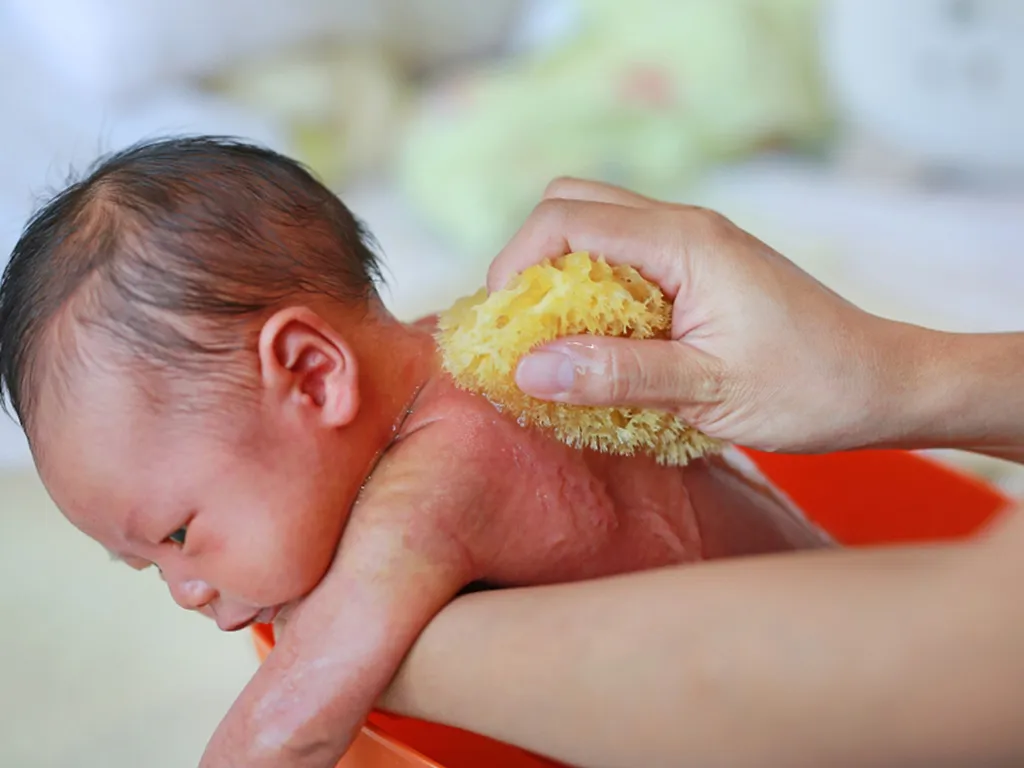
Please ensure that after wiping the baby clean with a wet washcloth, you pat dry, especially in the crease areas. Excessive moisture on your baby’s skin can cause skin irritation.
6. Umbilical Cord Care
Put your baby in a diaper and a t-shirt before cleaning the umbilical cord. Use a cotton ball to clean the base of the cord and the area around it. It is important to clean the cord properly because the quicker the base dries, the sooner the cord will fall off.
Also, never cover the umbilical cord with the diaper to avoid chances of infection. It’s important to leave it dry and clean. Don’t over rub as trauma can cause bleeding.
7. Moisturising
Your newborn’s sponge bath will be incomplete without moisturisation. Use a mild moisturizer after the bath to keep your baby’s skin smooth, soft and healthy.
It is essential to ensure that the baby’s skin retains its suppleness. Keep a moisturising lotion handy for application after the bath. Choosing a mild lotion is advisable.
8. Dressing
Choose loose cotton clothes for your baby. Since the baby spends most of the day lying down, avoid picking clothes which have buttons or zippers down the back. It is also important to have a receiving blanket ready to wrap your baby in after the bath.
Are There Any Risks of Sponge Bathing?
While sponge bathing is generally safe, there are a few risks to be aware of, especially if it’s not done correctly. Here’s a look at some potential risks of sponge bathing.
- Sponge baths, especially in colder environments, can cause your baby to become cold if they are not wrapped in a towel or kept warm. Ensure the room is warm and that the baby’s body is covered as much as possible to avoid any discomfort or sudden temperature changes.
- Do you use soap for newborn sponge baths? Using harsh soaps or scrubbing too vigorously can irritate the skin, especially for babies or those with sensitive skin. Always use mild, gentle cleansers and a soft cloth to avoid damaging the skin’s delicate surface.
How Frequently Should You Give Your Baby a Sponge Bath?
The frequency of giving your baby a sponge bath depends on their age, skin condition, and general hygiene needs. For newborns, sponge baths are typically given 2-3 times a week unless they get visibly dirty or sweaty. After the umbilical cord stump falls off (usually around 1-3 weeks), you can give sponge baths more frequently if needed. However, over-bathing may cause dryness or irritation, so it’s essential to avoid daily sponge baths unless necessary.
For older babies or toddlers, sponge baths can be given as needed when a full bath isn’t possible or when you’re simply cleaning specific areas. Generally, babies don’t need to be bathed every day, as their skin is sensitive and can dry out with too much washing (5).
Precautions to Take While Sponge Bathing
When giving your baby a sponge bath, there are several precautions to ensure the process is safe, comfortable, and hygienic. Taking the right steps can help avoid any potential risks and make the experience more enjoyable for both you and your baby.
- Prepare the Environment: Before starting the sponge bath, make sure the room is warm and free from drafts. Babies are prone to getting cold, so it’s essential to maintain a comfortable temperature. A warm room will help prevent your baby from feeling chilled during the bath.
- Use a Soft, Clean Cloth: Always use a soft, clean washcloth or sponge to avoid irritating your baby’s sensitive skin. Make sure the cloth is damp but not soaking wet to prevent any risk of dripping water onto the baby’s skin.
- Avoid Harsh Soaps: Use only mild, baby-safe cleansers to prevent skin irritation. Harsh soaps or those with added fragrances can dry out or irritate your baby’s skin. Keep the use of soap minimal and focus on cleaning areas that need it the most, like the diaper area and neck folds.
- Keep the Baby Covered: Only expose the part of your baby’s body that you’re cleaning to minimize heat loss. Keep the rest of their body wrapped in a towel to maintain warmth, especially in cooler environments.
- Be Gentle: Use gentle strokes while wiping your baby’s skin, and avoid scrubbing too hard. Babies have delicate skin that can easily become irritated, so a soft touch is essential for comfort and safety.
- Dry Baby Thoroughly After the Bath: After the bath, gently pat your baby dry with a soft towel, especially in skin folds like around the neck, behind the ears, and under the arms, where moisture can get trapped and cause irritation or rashes.
FAQs
1. Can I give my baby a sponge bath if they have a rash?
If your baby has a rash, it’s important to be extra cautious. Sponge baths can still be given, but use a gentle touch and avoid any areas where the rash is most irritated. If the rash appears to be severe or worsening, consult your pediatrician before continuing with sponge baths.
2. Is it safe to use baby oil during a sponge bath?
While baby oil can be soothing for dry skin, it’s generally not recommended to use it during a sponge bath, as it can leave a greasy residue on the skin. Instead, opt for a mild, baby-safe lotion after the bath to moisturize your baby’s skin.
3. Can I use wet wipes instead of a sponge bath for my newborn?
While wet wipes are convenient for quick clean-ups, they should not replace a full sponge bath for newborns. Wet wipes may contain chemicals or fragrances that could irritate your baby’s sensitive skin. A sponge bath with a damp cloth is a gentler and safer alternative.
A sponge bath is easier on the baby compared to a regular tub bath. Additionally, you can regulate the quantity of water that each body part of the baby receives. This can be helpful in keeping areas such as the umbilical cord dry. Wish you and your little angel a happy bonding time during a bath!
References/Resources:
1. Bathing Your Baby; American Academy of Pediatrics; https://www.healthychildren.org/English/ages-stages/baby/bathing-skin-care/Pages/Bathing-Your-Newborn.aspx
2. Quattrin. R, Iacobucci. K, Tina. A, Gallina. L; 70% Alcohol Versus Dry Cord Care in the Umbilical Cord Care; National Library of Medicine; https://pmc.ncbi.nlm.nih.gov/articles/PMC4998765/; April 2016
3. Bathing Your Baby; Nemours Kids Health; https://kidshealth.org/en/parents/bathing-baby.html
4. Best Tips for Giving Your Newborn Baby a Bath; University Hospitals; https://www.uhhospitals.org/blog/articles/2021/10/best-tips-for-giving-your-newborn-baby-a-bath
5. How often should you bathe your baby, from birth through early childhood?; UT Southwestern Medical Center; https://utswmed.org/medblog/how-often-bathe-newborn-baby/
Also read:
Bathing Your Baby
Baby’s Bath Temperature
Is Co-Bathing With Your Baby Safe?
Sponge Bath vs. Tub Bath For Your Baby
Was This Article Helpful?
Parenting is a huge responsibility, for you as a caregiver, but also for us as a parenting content platform. We understand that and take our responsibility of creating credible content seriously. FirstCry Parenting articles are written and published only after extensive research using factually sound references to deliver quality content that is accurate, validated by experts, and completely reliable. To understand how we go about creating content that is credible, read our editorial policy here.







